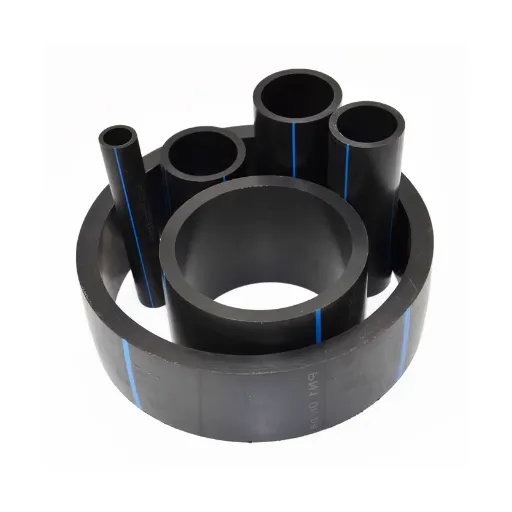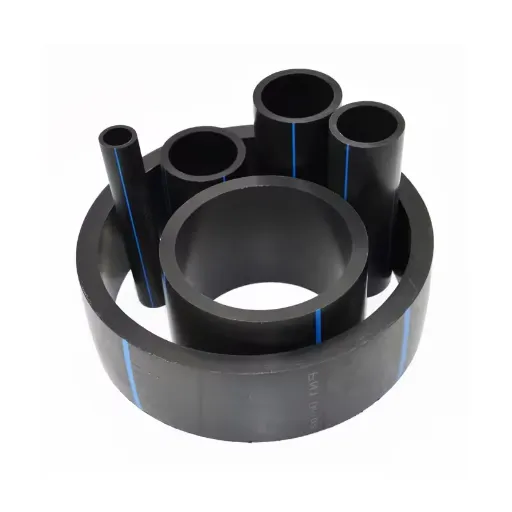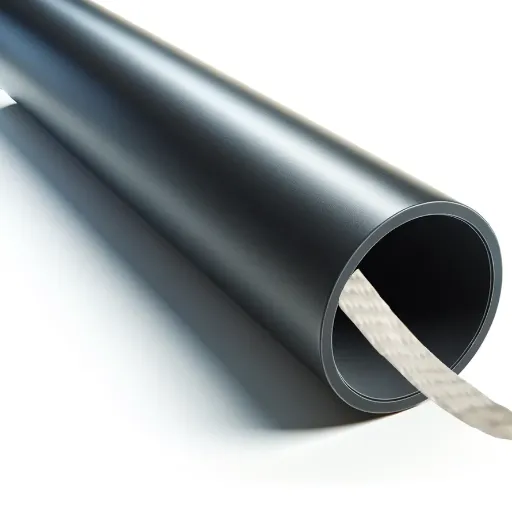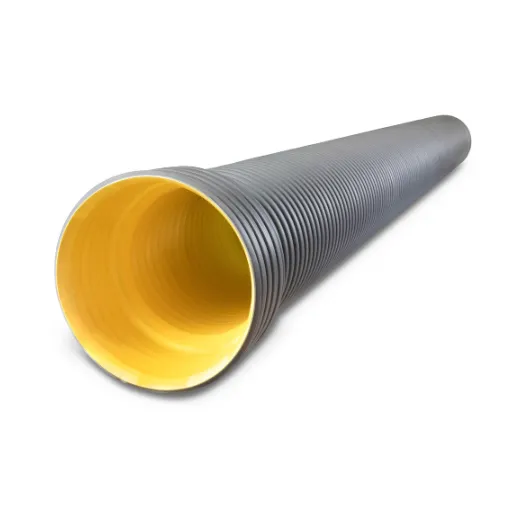In the world of water infrastructure, HDPE pipe is the newer technology solution for water transportation that serves sustainability and reliability purposes. The pipe is said to be good for the underground water supply system due to its strength, flexibility of application, and resistance to environmental stress from agricultural to municipal water systems to industrial applications. Conventional pipes have been a traditional choice for water transportation. But what concerns HDPE pipes as so good for underground water supply systems, and are they worthy to be considered alongside traditional pipes? This article explores the need for HDPE pipes: their advantages, applications, and why they continue to be a premium solution for efficient and lasting water distribution. Stay here as we delve into all the knowledge you need concerning this important infrastructure.
Introduction to HDPE Pipe
What is HDPE Pipe?
HDPE pipe is a plastic piping system that is fabricated from polyethylene, an extraordinarily durable and flexible polymer. It has a strength-to-density ratio greater than other plastics. HDPE pipes are light in weight but exceptionally tough, thus it is best suited for heavy-duty applications such as the supply of water, transporting gas, or creating sewer systems. HDPE, in contrast with steel and concrete, is not susceptible to corrosion, so it retains service life longer, even under harsh conditions.
Some of the important features shared by HDPE pipes include their flexibility and resistance to external pressure. This allows them to sit well with the movement of soils, temperature fluctuations, and other environmental changes that could otherwise cause concrete to crack and break. Inside, these pipes also have a very smooth surface that tends to reduce friction, aiding in the efficient flow of water or other fluids. These features really make HDPE pipes stand out for projects where a high degree of efficiency and long-term guarantees are foremost requirements.
Considered to be quite cost-efficient and environmentally-friendly, HDPE pipes are easy to use and require fewer joints as they are manufactured in large lengths. These features ultimately reduce the combined installation and maintenance cost of the piping system-hence minimizing environmental impact. It is these very benefits that make HDPE pipes the single most preferred type of piping used by myriad infrastructure projects across the globe.
Why Choose HDPE for Underground Water?
Therefore, HDPE Pipes serve best when it comes to underground water conveyance procedures due to their superior durability and flexibility. Corrosion and chemical resistance properties prolong the lifetime of HDPE pipes even under adverse soil conditions or problematic contaminants present in water. Furthermore, they are trustworthy in underground installation as they can bear very high pressure.
By and large, HDPE pipes are perfectly leak-proof. Contrasted with other materials, HDPE pipes can join by fusion welding, resulting in a continuous weld-free joint, thus preventing leakage. Hence, they stand to conserve water and will reduce maintenance as they age. They are also very flexible, meaning they are less likely to get damaged as they move through the ground, due to seismic activity or ground shifts.
Light in weight, HDPE pipes save hugely on the cost of labor and time when it comes to infrastructure projects. They have that ability of being adaptable to a wide array of temperatures and pressure conditions. They are also environmentally safe since they are 100% recyclable, and look towards the sustainability of construction. From the standpoint of cost, durability, and maintenance, HDPE is an attractive solution for underground water applications.
Overview of Polyethylene and Its Properties
In general, PE is considered the most popular thermoplastic due to its versatility and robust properties. It is obtained by polymerization of ethylene, and it exists in various forms: high-density polyethylene (HDPE) and low-density polyethylene (LDPE), according to further classification, each suited for different purposes. From its chemical nature, polyethylene combines flexibility and strength, giving inadequate packaging, piping, and other industrial uses.
Polyethylene is best known for its durability and chemical resistance. Being highly inert and minimally reactive with acids, bases, and moisture provides it longevity in harsh environments. A good breaking strength provided by polyethylene also imparts its shock-resistance property. All these factors combined create various possibilities for polyethylene uses in protective packaging and even structural applications.
Polyethylene is extremely valued for its lightness and for the fact it is recyclable. Because of its lower density, polyethylene is lighter to carry and handle, thereby reducing costs in manufacturing and logistics. Polyethylene is 100% recyclable and supports operations with respect to the environment. It can be recycled to be transformed into new raw materials and the final product, eventually reducing the sheer amount of pollution in the surrounding environment. Ultimately, owing to its unique combination of properties, polyethylene has established itself as an imperishable material in industries worldwide.
Advantages of HDPE Pipes
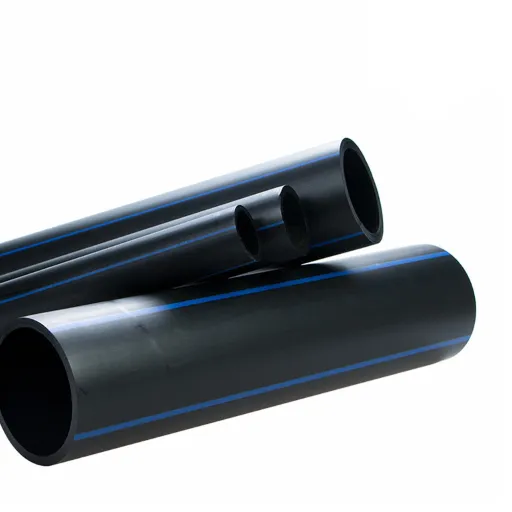
Durability and Longevity
🛡️ High Corrosion Resistance
HDPE pipes resist chemical corrosion better than the metal pipes. This makes them fit to be used in applications where the pipes encounter aggressive chemicals or salty atmospheres.
💪 Impact Resistance
Being flexible, HDPE pipes endure external impacts without cracking and breaking. Such a property is of utmost importance when installing these pipes in areas of shifting or unstable soil.
☀️ UV and Weather Resistance
HDPE pipes are designed and manufactured to withstand outdoor conditions and resist deterioration due to long exposure to ultraviolet (UV) rays and weather conditions.
🔧 Leak-Free Joints
HDPE pipes are joined using the heat fusion method, making the joints leak-proof thereby preventing water losses from leakage while ensuring structural integrity for a long time of use.
⏳ Long Service Life
With proper installation and maintenance, HDPE pipes can last from 50 to 100 years, which is quite long compared to many traditional pipe materials. Hence, it stands out for its durability, sparing some replacement cost.
Resistance to Corrosion and Chemicals
HDPE pipes are recognized for their high resistance to corrosion and to various chemical agents. This makes them suitable for industries where abrasive conditions and demanding environments exist. Here are five major reasons why they are considered to have super chemical and corrosion resistance:
- Corrosion Resistance:
HDPE pipes do not corrode or rust with moisture exposure and need water metals, unlike traditional metal pipes.
- Chemical Resistance:
HDPE pipes resist a wide range of aggressive chemicals, acids, alkalis, and hydrocarbons being among them, thereby ensuring the performance of industries in which pipework might normally expect a corrosive environment.
- Biofouling Resistance:
Its smooth inside surface of HDPE pipe tends to resist biofouling and scaling, thereby maintaining high flow efficiency and lowering maintenance requirements.
- UV Resistance:
HDPE pipes manufactured with UV stabilizers resist degradation, photochemical attack, and cracking due to prolonged exposure to sunlight and hence render constant performance outdoors.
- Saltwater and Marine Applications:
HDPE pipes do not allow the ingress of saltwater, thus rendering them suitable for marine and coastal works where the materials may get degraded in an environment of salt.
This set of resistances allows HDPE pipes to budget towards pipe performance in a range of adverse conditions, assuring reliability and prolonged lifetime.
Cost-Effectiveness in Water Systems
HDPE pipes offer a cheaper solution for water supply systems as they are durable while demanding minimal maintenance and having a long life. By incorporating these pipes, the expenses can further be minimized while ensuring effective water distribution in both urban and rural areas. Here are five important aspects making HDPE pipes economically attractive:
1
Low Installation Costs
These pipes weigh-way less and offer a lot more flexibility in installation when compared to concrete or steel. This reduces the team working hours on the site and procedure time.
2
Reduced Maintenance Costs
Corrosion-resistant HDPE pipes offer solid physical resistance to destructive handling, thus making repairs and replacements a rarely-done practice, keeping long-term maintenance very cheap.
3
Extended Lifespan
Depending on their use and exposure conditions, HDPE pipes will provide an estimated service life of 50-100 years, in turn ensuring a return on investment over the long haul.
4
Energy-Efficient Transport
Hydraulically smooth surfaces reduce friction between HDPE pipes and the flowing fluid, requiring lesser amounts of energy for pumping water. Thus, operational cost savings may be realized with time.
5
Trenchless Techniques Adaptability
Flexible HDPE pipes are amenable to trenchless installation techniques, such as directional drilling or slip lining, which require less disruption to the land and restoration costs.
All these factors indicate that HDPE pipes serve to cost-efficiently, yet ensuring top performance and reliability, water systems.
Applications of HDPE in Underground Water Supply
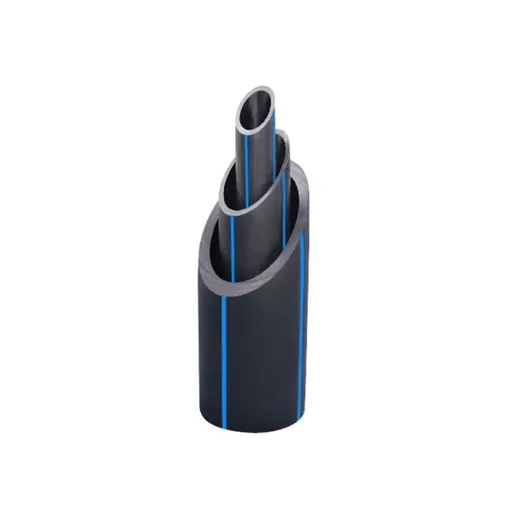
Water Distribution Networks
HDPE pipes have an eminent role to play in water distribution because of their toughed durability, greater flexibility, and corrosion resistance. Here are the chief uses of HDPE pipes in water distribution:
| Application | Description |
|---|---|
| Municipal Water Supply Systems | For potable water supply, HDPE pipes are being used extensively in urban and rural areas. It can withstand higher pressure in systems, thus ensuring the reliable and longer life of water supply. |
| Irrigation Network | Agriculture is entirely depends upon HDPE pipes for drip irrigation and sprinkler systems, which efficiently deliver water with almost nil leakage. |
| Industrial Water Distribution | HDPE pipes are industrially used to supply water for cooling, processing, or manufacturing operations because they provide chemical resistance and high performance. |
| Fire Protection Systems | These pipes can be used for underground fire protection networks as they withstand very high pressures, and water supplied during emergencies is quite reliable. |
| Rural Water Supply Projects | Being easy to install and maintain with very little upkeep, HDPE pipes are the best choice for remote areas and for long-distance water transportation. |
Such cases illustrate how HDPE pipes aid in efficient and sustainable water distribution solutions in the different sectors.
Residential and Commercial Water Lines
HDPE pipes are perfectly apt for water line systems in both residential and commercial sectors due to their usability with flexibility, durability, and corrosion resistance. Five applications of HDPE pipes in residential and commercial works are given below:
- ✓
Drinking Water Supply: HDPE pipes are the best choice for delivering clean and safe drinking water, complying with health and safety standards. Its non-toxic nature ensures no contamination occurs.
- ✓
Irrigation: Due to their ability to withstand pressure and the rigors of frequent water flow, these pipes find wide application in irrigation for both residential landscaping and commercial irrigation.
- ✓
Sewage and Drainage: In both residential and commercial buildings, HDPE pipes serve to alleviate sewage and drainage systems, avoiding leaks, and ensuring long-term reliability.
- ✓
Wet Fire Protection Systems: They support crucial fire suppression lines and are highly resistant to pressures needed in emergencies.
- ✓
Geothermal Heating and Cooling: These represent natural and eco-friendly types of heat pumps, with HDPE pipes used for heat transfer in the geothermal process to reduce energy consumption and further the goal of sustainability.
These various types of applications stand as testimony of HDPE pipes’ strength, thus rendering them practicable and efficient in securing solutions for residential and commercial water line systems.
Municipal Water Supply Systems
The water infrastructure for municipal use is intended to be durable, cost-effective, and capable of transporting large volumes of water efficiently. HDPE pipes, owing to their ability to resist corrosion, long life, and smooth flow characteristics, have emerged into their own in this field. Below are five areas where HDPE pipe finds application in municipal water supply systems:
Main Water Distribution Lines
Water is transported through HDPE pipes from treatment plants to storage tanks and distribution networks. Owing to their flexibility and strength, they are well suited for applications in long-duration main water supply lines.
Service Connections
These are the pipes which connect a particular home or building to water main lines. HDPE pipe provides a more reliable, leak-proof connection which is easy to install.
Replacement of Aging Pipelines
HDPE pipes are mostly used for the replacement of old, dilapidated pipelines in municipal systems, giving a cost-effective alternative in infrastructure upgrading.
Pressure Sewer Systems
HDPE pipes do well with pressure systems for potable water and wastewater systems. It is used to transfer water safely and hygienically across municipalities.
Stormwater and Drainage Systems
HDPE pipes are further employed in stormwater management to get rid of runoff water, thus reducing the chances of flooding and protecting urban ecosystems.
These applications more clearly defend the place of HDPE pipes in keeping municipal water supply systems functional and efficient so that communities may enjoy clean, safe, and sustainable sources of water.
HDPE Pipe Fittings
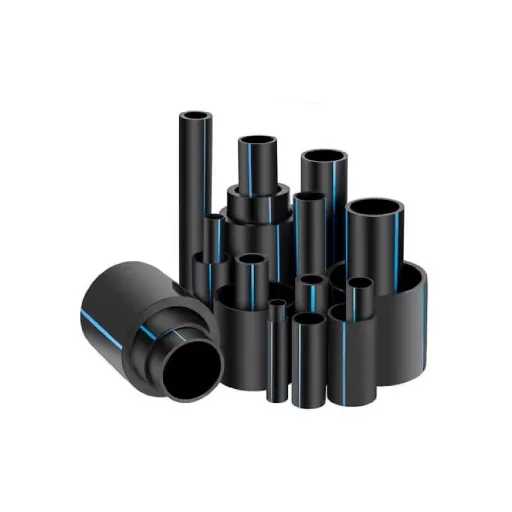
Types of HDPE Fittings
HDPE pipe fittings serve as important components that join, adapt to, or repair HDPE pipelines. These fittings work towards maintaining the integrity of the pipeline, ensuring smooth flow, and providing durability. Some of the major types of HDPE fittings are:
🔌 Electrofusion Fittings
Fittings supplied with internally mounted heating elements that can be used to weld pipes, giving them a secure and leak-free type of connection. The commonly dealt types of electrofusion fittings include couplers, elbow, and branch saddles. They are reliable and commonly used in gas, water, and industrial systems.
🔗 Butt Fusion Fittings
An absolutely clean connection where the pipes are held together with heat and pressure by means of butt fusion fittings. This type of fitting is mostly used where high-pressure application prevails because of strength and uniform performance.
🔧 Compression Fittings
The ease of installation without the need for special tools or equipment is one of the major features of compression fittings. They find applications in systems that require quick and flexible pipe joining, such as irrigation and drinking water supply.
⚙️ Flange Fittings
When easy assembly and disassembly are required, flange fitting applications can be found. This happens mostly for temporary installations or for systems that need maintenance. They are much the way bolted connections are secured by the use of gaskets with the best sealing power.
🔥 Socket Fusion Fittings
Just as in electrofusion, socket fusion fitting joins pipe through the heated socket method. It provides a very strong and permanent joint and is suitable for small diameter pipelines in plumbing and fluid distribution systems.
🔄 Spigot Fittings
Spigot fittings are straight connections, usually made with other fusions to form a stronger joint. They are utilized primarily in industrial set-ups where systems are expected to be stronger yet flexible.
Considered for the highest versatility, chemical resistance, and fitting to the utmost seamless interface with HDPE pipes, HDPE fittings utilize the latest technology so that the whole system shall work efficiently and withstand even extreme industrial or municipal applications.
Installation Guidelines for HDPE Fittings
Proper installation of HDPE fittings is key to ensuring the system’s efficiency and longevity. It starts by making sure that the HDPE pipes and fittings are clean and free from dirt, dust, or moisture before joining. Use accurate pipe dimensioning tools for precision cutting to eliminate irregularities that could obstruct the joint.
For heat fusion, the heating equipment needs to be pre-set to the right temperature as per the manufacturer’s instructions, usually in the range of 390 to 450 degrees Fahrenheit. Pipes and fittings must be perfectly aligned when fusion takes place; otherwise, there will be stress on the joint once cooling. Cooling time must be allowed suitably in each joint before any load, pressure, or handling is applied.
It would be necessary to apply the right torque to mechanical fittings to prevent over-tightening and damaging the fitting, or under-tightening and leaking. Installation should be performed under the correct weather conditions, as extreme weather can affect the materials. For underground applications, proper trench bedding and backfilling should be considered so as to avoid any stress or deformation to the pipe as it ages.
In case of any doubt, always take reference from installation manuals provided by the manufacturer, because a different model or brand may have specific requirements based on its design. Periodic inspections and pressure testing should be conducted after installation to ensure that the system is sufficiently intact prior to full-scale operations.
Common Challenges and Solutions
This installation and maintenance of piping system may seem simple; however, certain challenges can arise that can hamper performance or longevity. Below are some common challenges and practical solutions:
| Challenge | Solution |
|---|---|
| Pipe Corrosion | Corrosion ranks among the major problems faced, especially in metallic piping systems. Corrosion may cause leakages, compromised flow efficiency, or pipe breakage. To counter this, use corrosion-resistant material like stainless steel or paint protective coating on them. Plastic or composite pipes are also a great alternative in such situations where high moisture and chemical exposure exist. Another step to increase corrosion resistance is proper system designing and implementing anti-corrosion treatments on a regular basis. |
| Pressure Fluctuations | Instantaneous pressure fluctuations, famous as water hammer, might strain the piping system and cause bow joints and valves. Installation of pressure relief valves or surge tanks could ensure the balance of pressure loads. Also, proper supports for pipes will help reduce the chances of pipe movement due to pressure variations. |
| Clogging and Flow Restrictions | This basically means whatever substances or sediments settle inside the pipe decrease the flow of water or totally choke the system. Periodic flushing of systems or installation of filtration systems at intake points can help prevent clogging. For older systems, periodic inspection needs to be scheduled to find the extent of damage so that later growth can be prevented immediately. |
| Extremes of Temperature | Because piping systems exist in places that are subject to temperature changes, therefore, they either crack or warp, or there occurs an expansion mismatch. To guard them from such stresses due to temperature variations, make use of suitable materials with respect to their operational temperature and employ either an expansion joint or thermal insulation. |
| Improper Installation | Being set wrongly will misalign, weaken the joint, or provide an unseal. Hence, adherence to instructions, along with employing trained professionals for installation, should be regarded as necessary. Advancements such as automated welding and digital alignment systems can also ensure precision at installation. |
Once identified, preemptive action of these problems, along with their suitable cures, enables an efficient system that works in full safety through to the end of its expected life. Using routine maintenance and innovations that are technology-driven can enhance durability even more and minimize downtime.
Best Practices for Using HDPE Pipes
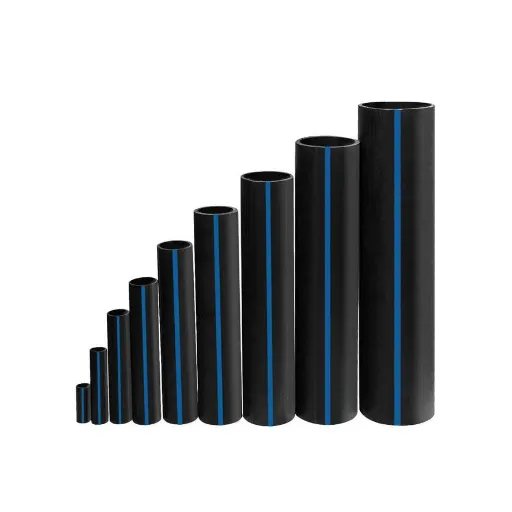
Installation Techniques for Underground Water Pipes
Long-term use of and resistance to the underground water systems require proper pipe installation using HDPE pipes. By way of example, one needs to carefully evaluate site conditions for soil type, the presence of groundwater, and load-bearing capacity, among other parameters, as they determine trench design. Trenches stand to be excavated to such heights that there is at least 4 to 6 inches of bedding made out of compacted granular material so that the pipes will not sag and are uniformly supported.
When placing the pipe on the ground, avoid dragging it over any sharp objects that might damage its surface. Butt fusion or electro-fusion techniques are preferred for joining pipes as they provide a very secure weld, with no leakage caused by pressure variations. Placed after joining, the pipes need to be lowered carefully into their trench to maintain alignment with minimal stress applied to the pipe.
Backfilling must be carried out in phases. The first layer should consist of fine soil-like material to provide a uniform covering and surrounding for the pipe. The succeeding layers should be properly compacted with non-cohesive granular material to give further stability, but neither should they be compacted with intense force that deforms the pipe. If these methods are followed, it may eliminate plenty of trouble in the future such as leaks, pipe deformation, or misalignment. With such treatment-and installation combination, the underground water systems will be sure to be more efficient and have a longer working life.
Maintenance Tips for HDPE Pipe Systems
Maintenance plays a very important role in making HDPE pipe systems last longer and serving that purpose efficiently. Regular inspections of a system shall be done on a regular basis to identify any wear signs: abrasions, cracks in the material, or any deformation. Should any such damage be found, it must be fixed at an early stage before any leak or failure may occur. Cleaning must be done periodically so that sediment or debris does not develop and block the system. The joints must also be checked to ensure that no external stresses can cause misalignment or joint damage with the passage of time.
In buried HDPE systems, monitoring the soil conditions around the pipes becomes extremely important. Soil shifting or excessive moistures can affect the system stability, making some corrective measures such as re-compaction or drainage upgrades necessary. Furthermore, it may be considered to install pressure monitors in systems with high flowrates to detect abnormal variations, which may indicate blockages or system weaknesses. Modern-day monitoring with remote or automated sensors provides real-time data on system performance to enable quick responses to imminent issues.
Maintaining these systems under these strategies along with improvements in technology will ensure that HDPE pipe systems operate at maximum efficiency with less downtime, and afford a longer useful life.
Common Mistakes to Avoid When Using HDPE
When it comes to HDPE pipes, there are a bunch of common mistakes that can reduce their efficiency and service life. One big mistake is installing them the wrong way such as missing out on thermal expansion or contraction. HDPE pipes expand or contract with changes in temperature; if neglected, stress imposed on the system would cause it to leak or break down structurally. In contrast, jointing errors often occur: failure to employ correct or good-quality joining methods may weaken connections, thus making them more susceptible to breakdowns.
Ignoring soil conditions during installation can cause problems in the long run. Placement of pipes in unsuitable soils without regard for proper bedding and backfilling materials can lead to deformation and failure due to external pressures. Failure to perform maintenance and inspections of the system ranks as other important installation errors. Without routine inspections, minor problems such as abrasions, clogging, or wear and tear of the system could develop into a major failure. Another such installation mistake is neglecting to check for compatibility of the materials; while HDPE resists most chemicals, materials exposed to incompatible or harsh substances will undergo degradation over time, losing efficiency and reliability.
Elimination of these errors, supported by thorough planning and advanced monitoring techniques, will guarantee the strength and efficiency of HDPE pipe systems under varied applications.
References
- Developed Pipe Bursting Specifications Using High-Density Polyethylene (HDPE)
This paper discusses the properties and applications of HDPE pipes, including their flexibility and impact on underground installations. - Analyzing Field Performance of Steel-Reinforced HDPE (SRHDPE) Pipes During Installation and Under Traffic Loading
This study evaluates the performance of HDPE pipes under various conditions, including installation and traffic loads. - Laboratory and Field Performance of Buried Steel-Reinforced High-Density Polyethylene (SRHDPE) Pipes
This research focuses on the performance of HDPE pipes in ditch conditions and under shallow covers.
Frequently Asked Questions (FAQ)
Q: What is HDPE pipe, and what role does it play in underground water supply?
A: HDPE pipe-the high-density polyethylene pipe-is a strong yet flexible piping material used commonly for underground underground water supply systems. It is manufactured to provide for the safe transportation of potable water; thus, it stands as an ideal pipeline for use in houses and municipal water distribution systems.
Q: For underground applications, why should I choose HDPE pipes?
A: There are many reasons to choose HDPE pipes underground, like corrosion resistance, flexibility, and high pressure resistance. These characteristics of the HDPE pipes are useful for different water supply systems, either industrial or residential.
Q: Does pipe diameter of HDPE affect water flow?
A: Pipe size is an essential factor that dictates water flow in the system. Larger-diameter HDPE pipes are able to accommodate larger volumes of water and distribute it effectively. Appropriate sizing is necessary to ensure the optimal pressure and flow rates needed in your underground water supply system.
Q: Are HDPE pipes cheaper than the conventional metal pipes?
A: Yes, generally, HDPE pipe costs less than traditional metal pipes, including iron or ductile iron pipe. Durability and low maintenance costs of HDPE pipes add to the savings for any water supply system, making it a perfect choice.
Q: How do HDPE pipes contribute to the maintenance of water quality?
A: HDPE pipes are capable of inhibiting the growth of biofilm and do not leach any harmful chemicals into the water, thus preserving the quality of water. Such pipes are appropriate for those applications where it is of utmost importance to maintain water purity, such as municipal water systems and potable water systems.
Q: What types of fittings are necessary for HDPE pipe installations?
A: HDPE pipe fittings are actually used to secure and make sure that the connection stays impervious to water. Different kinds of fittings, such as tees, elbows, and reducers, are available based on different layouts and pipe sizes to guarantee a reliable underground water distribution system.
Q: Can HDPE pipes be used in hot water applications?
A: While HDPE pipes are mostly for cold water applications, certain types of HDPE pipes might be used in hot water applications if temperature and pressure ratings are met. Thus, it is imperative to have the correct pipe for your needs to ensure safety and performance.
Q: What benefits does the flexibility of HDPE pipe impart for underground installations?
A: The flexibility of HDPE allows for easy installation over different terrains, thus lessening extensive trenching and disturbance of the surrounding area. This very flexibility makes HDPE an excellent set-up in underground water supply systems, particularly over difficult terrain.
Q: How would one choose the right one for his underground water supply?
A: Factors such as application, size, pressure, and available standard at your local place are to be considered while choosing the right HDPE pipe for the project. A professional may better help you decide on the right type of HDPE to buy for your underground water supply needs.
HDPE pipes represent the future of sustainable and efficient water infrastructure. Their superior durability, cost-effectiveness, and environmental benefits make them the ideal choice for underground water supply systems across all applications.



